
John Harvey Kellogg
First Book in Physiology and Hygiene
CHAPTER VI
OUR DRINKS
1. Water is really the only drink. It is the only substance which will satisfy thirst. All other fluids which we drink consist mostly of water. Thus, lemonade is lemon-juice and water. Milk is chiefly water. Wine, beer, cider, and such liquids contain alcohol and many other things, mixed with water.
2. Why we Need Water.—If we should wet a sponge and lay it away, it would become dry in a few hours, as the water would pass off into the air. Our bodies are losing water all the time, and we need to drink to keep ourselves from drying up.
3. Water is also very necessary for other purposes. It softens our food so that we can chew and swallow it, and helps to carry it around in the body after it has been digested, in a way about which we shall learn in future lessons.
4. Still another use for water is to dissolve and wash out of our bodies, through the sweat of the skin, and in other ways, the waste and worn-out particles which are no longer of any use.
5. Impure Water.—Most waters have more or less substances dissolved in them. Water which has much lime in it is called hard water. Such water is not so good to drink, or for use in cooking, as soft water. That water is best which holds no substances in solution. Well-water sometimes contains substances which soak into wells from vaults or cesspools. Slops which are poured upon the ground soak down out of sight; but the foul substances which they contain are not destroyed. They remain in the soil, and when the rains come, they are washed down into the well if it is near by. You can see some of the things found in bad water in the illustration given on opposite page.
6. It is best not to drink iced water when the body is heated, or during meals. If it is necessary to drink very cold water, the bad effects may be avoided by sipping it very slowly.
7. Tea and Coffee.—Many people drink tea or coffee at their meals, and some persons think that these drinks are useful foods; but they really have little or no value as foods. Both tea and coffee contain a poison which, when separated in a pure form, is so deadly that a very small quantity is enough to kill a cat or a dog. This poison often does much harm to those who drink tea or coffee very strong for any great length of time.
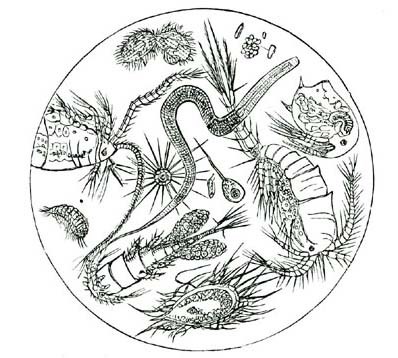
A DROP OF IMPURE WATER MAGNIFIED.
8. Alcohol (al´-co-hol).—All of you know something about alcohol. Perhaps you have seen it burn in a lamp. It will burn without a lamp, if we light it. It is so clear and colorless that it looks like water. The Indians call it "fire-water." Alcohol differs very much from foods. It is not produced from plants, as fruits and grains are; neither is it supplied by Nature ready for our use, as are air and water.
9. Fermentation.—When a baker makes bread he puts some yeast in the dough to make it "rise," so the bread will be light. The yeast destroys some of the sugar and starch in the flour and changes it into alcohol and a gas. The gas bubbles up through the dough, and this is what makes the bread light. This is called fermentation (fer-men-ta´-tion). The little alcohol which is formed in the bread does no harm, because it is all driven off by the heat when the bread is baked.

FERMENTATION.
10. Any moist substance or liquid which contains sugar will ferment if yeast is added to it, or if it is kept in a warm place. You know that canned fruit sometimes spoils. This is because it ferments. Fermentation is a sort of decay. When the juice of grapes, apples, or other fruit is allowed to stand in a warm place it "works," or ferments, and thus produces alcohol. Wine is fermented grape-juice; hard cider is fermented apple-juice.
11. Beer, ale, and similar drinks are made from grains. The grain is first moistened and allowed to sprout. In sprouting, the starch of the grain is changed to sugar. The grain is next dried and ground, and is then boiled with water. The water dissolves the sugar. The sweet liquid thus obtained is separated from the grain, and yeast is added to it. This causes it to ferment, which changes the sugar to alcohol. Thus we see that the grain does not contain alcohol in the first place, but that it is produced by fermentation.
12. All fermented liquids contain more or less alcohol, mixed with water and a good many other things. Rum, brandy, gin, whiskey, and pure alcohol are made by separating the alcohol from the other substances. This is done by means of a still, and is called distillation.
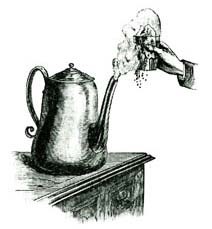
DISTILLATION.
13. You can learn how a still separates the alcohol by a little experiment. When a tea-pot is boiling on the stove and the steam is coming out at the nozzle, hold up to the nozzle a common drinking-glass filled with iced water, first taking care to wipe the outside of the glass perfectly dry. Little drops of water will soon gather upon the side of the glass. If you touch these to the tongue you will observe that they taste of the tea. It is because a little of the tea has escaped with the steam and condensed upon the glass. This is distillation.
14. If the tea-pot had contained wine, or beer, or hard cider, the distilled water would have contained alcohol instead of tea. By distilling the liquid several times the alcohol may be obtained almost pure.
15. Alcohol kills Animals and Plants.—Strong alcohol has a deadly effect upon all living things. Once a man gave a dog a few tablespoonfuls of alcohol, and in a little while the dog was dead. If you should pour alcohol upon a plant it would die very soon.
16. A man once made a cruel experiment. He put some minnows into a jar of water and then poured in a few teaspoonfuls of alcohol. The minnows tried very hard to get out, but they could not, and in a little while they were all dead, poisoned by the alcohol. A Frenchman once gave alcohol to some pigs with their food. They soon became sick and died.
17. Alcohol not a Food.—There are some people who imagine that alcohol is good for food because it is made from fruits and grains which are good for food. This is a serious mistake. A person can live on the fruits or grains from which alcohol is made, but no one would attempt to live upon alcohol. If he did, he would soon starve to death. In fact, men have often died in consequence of trying to use whiskey in place of food.
18. We should remember, also, that people do not take alcohol as a food, but for certain effects which it produces, which are not those of a food, but of a poison.
19. Many people who would not drink strong or distilled liquors, think that they will suffer no harm if they use only wine, beer, or cider. This is a great mistake. These liquids contain alcohol, as do all fermented drinks. A person will become drunk or intoxicated by drinking wine, beer, or cider—only a larger quantity is required to produce the same effect as rum or whiskey.
20. Another very serious thing to be thought of is that if a person forms the habit of drinking wine, cider, or other fermented drinks, he becomes so fond of the effect they produce that he soon wants some stronger drink, and thus he is led to use whiskey or other strong liquors. On this account it is not safe to use any kind of alcoholic drinks, either fermented or distilled. The only safe plan is to avoid the use of every sort of stimulating or intoxicating drinks.
21. It has been found by observation that those persons who use intoxicating drinks are not so healthy as those who do not use them, and, as a rule, they do not live so long.
22. This is found to be true not only of those who use whiskey and other strong liquors, but also of those who use fermented drinks, as wine and beer. Beer drinkers are much more likely to suffer from disease than those who are strictly temperate. It is often noticed by physicians that when a beer-drinker becomes sick or meets with an accident, he does not recover so readily as one who uses no kind of alcoholic drinks.
23. Alcoholic drinks not only make people unhealthy and shorten their lives, but they are also the cause of much poverty and crime and an untold amount of misery.
SUMMARY
1. Water is the only thing that will satisfy thirst.
2. In going through our bodies, water washes out many impurities. We also need water to soften our food.
3. The purest water is the best. Impure water causes sickness.
4. Good water has no color, taste, or odor.
5. Tea and coffee are not good drinks. They are very injurious to children, and often do older persons much harm.
6. Alcohol is made by fermentation.
7. Pure alcohol and strong liquors are made by distillation.
8. Alcohol is not a food, it is a poison. It kills plants and animals, and is very injurious to human beings.
9. Even the moderate use of alcoholic drinks produces disease and shortens life.
CHAPTER VII
HOW WE DIGEST
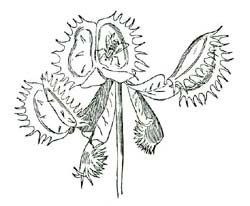
VENUS'S FLY-TRAP.
1. Did you ever see a Venus's fly-trap? This curious plant grows in North Carolina. It is called a fly-trap because it has on each of its leaves something like a steel-trap, by means of which it catches flies. You can see one of these traps in the picture. When a fly touches the leaf, the trap shuts up at once, and the poor fly is caught and cannot get away. The harder it tries to escape, the more tightly the trap closes upon it, until after a time it is crushed to death.
2. But we have yet to learn the most curious thing about this strange plant, which seems to act so much like an animal. If we open the leaf after a few days, it will be found that the fly has almost entirely disappeared. The fly has not escaped, but it has been dissolved by a fluid formed inside of the trap, and the plant has absorbed a portion of the fly. In fact, it has really eaten it. The process by which food is dissolved and changed so that it can be absorbed and may nourish the body, is called digestion (di-ges´-tion).

THE DIGESTIVE TUBE.
3. The Venus's fly-trap has a very simple way of digesting its food. Its remarkable little trap serves it as a mouth to catch and hold its food, and as a stomach to digest it. The arrangement by which our food is digested is much less simple than this. Let us study the different parts by which this wonderful work is done.
4. The Digestive Tube.—The most important part of the work of digesting our food is done in a long tube within the body, called the digestive tube or canal.
5. This tube is twenty-five or thirty feet long in a full-grown man; but it is so coiled up and folded away that it occupies but little space. It begins at the mouth, and ends at the lower part of the trunk. The greater part of it is coiled up in the abdomen.
6. The Mouth.—The space between the upper and the lower jaw is called the mouth. The lips form the front part and the cheeks the sides. At the back part are three openings. One, the upper, leads into the nose. There are two lower openings. One of these leads into the stomach, and the other leads to the lungs. The back part of the mouth joins the two tubes which lead from the mouth to the lungs and the stomach, and is called the throat. The mouth contains the tongue and the teeth.
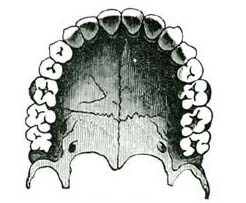
THE TEETH.
7. The Teeth.—The first teeth, those which come when we are small children, are called temporary or milk teeth. We lose these teeth as the jaws get larger and the second or permanent teeth take their place. There are twenty teeth in the first set, and thirty-two in the second. Very old persons sometimes have a third set of teeth.
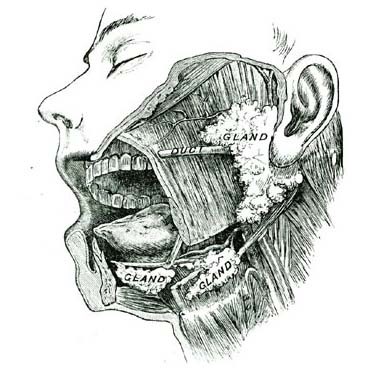
SALIVARY GLANDS.
8. The Salivary (sal´-i-vary) Glands.—There are three pairs of salivary glands. They form a fluid called the saliva (sa-li´-va). It is this fluid which moistens the mouth at all times. When we eat or taste something which we like, the salivary glands make so much saliva that we sometimes say the mouth waters. One pair of the salivary glands is at the back part of the lower jaw, in front of the ears. The other two pairs of glands are placed at the under side of the mouth. The saliva produced by the salivary glands is sent into the mouth through little tubes called ducts.
9. The Gullet.—At the back part of the throat begins a narrow tube, which passes down to the stomach. This tube is about nine inches long. It is called the gullet, food-pipe, or œsophagus (e-soph´-a-gus).
10. The Stomach.—At the lower end of the œsophagus the digestive tube becomes enlarged, and has a shape somewhat like a pear. This is the stomach. In a full-grown person the stomach is sufficiently large to hold about three pints. At each end of the stomach is a narrow opening so arranged that it can be opened or tightly closed, as may be necessary. The upper opening allows the food to pass into the stomach, the lower one allows it to pass out into the intestines. This opening is called the pylorus (py-lo´-rus), or gate-keeper, because it closes so as to keep the food in the stomach until it is ready to pass out.
11. In the membrane which lines the stomach there are many little pocket-like glands, in which a fluid called the gastric juice is formed. This fluid is one of the most important of all the fluids formed in the digestive canal.

GASTRIC GLAND.
12. The Intestine(in-tes´-tine).—At the lower end of the stomach the digestive canal becomes narrow again. This narrow portion, called the intestine, is about twenty-five feet long in a grown person. The last few feet of the intestine is larger than the rest, and is called the colon. This long tube is coiled up and snugly packed away in the cavity of the abdomen. In the membrane lining the intestines are to be found little glands, which make a fluid called intestinal juice.
13. The Liver.—Close up under the ribs, on the right side of the body, is a large chocolate-colored organ, called the liver. The liver is about half as large as the head, and is shaped so as to fit snugly into its corner of the abdomen. The chief business of the liver is to make a fluid called bile, which is very necessary for the digestion of our food.
14. The bile is a bitter fluid of a golden-brown color. It is carried to the intestine by means of a little tube or duct, which enters the small intestine a few inches below the stomach. When the bile is made faster than it is needed for immediate use, it is stored up in a little pear-shaped sac called the gall-bladder, which hangs from the under side of the liver.
15. The liver is a very wonderful organ, and does many useful things besides making bile. It aids in various ways in digesting the food, and helps to keep the blood pure by removing from it harmful substances which are formed within the body.
16. The Pancreas(pan´-cre-as).—The pancreas is another large and very important gland which is found close to the stomach, lying just behind it in the abdominal cavity. The pancreas forms a fluid called the pancreatic juice, which enters the small intestine at nearly the same place as the bile.
17. The Spleen.—Close to the pancreas, at the left side of the body, is a dark, roundish organ about the size of the fist, called the spleen. It is not known that the spleen has much to do in the work of digestion, but it is so closely connected with the digestive organs that we need to know about it.
18. Please note that there are five important organs of digestion. The mouth, the stomach, the intestines, the pancreas, and the liver.
19. Also observe that there are five digestive fluids, saliva, gastric juice, bile, pancreatic juice, and intestinal juice.
SUMMARY
1. The process of dissolving and changing the food so that it may be absorbed and may nourish the body is digestion.
2. The work of digestion is chiefly done in the digestive tube or canal, which is about thirty feet in length.
3. The mouth contains the teeth, and has three pairs of salivary glands connected with it, which make saliva.
4. The gullet leads from the mouth to the stomach.
5. The stomach is pear-shaped, and holds about three pints.
6. It has an upper and a lower opening, each of which is guarded by a muscle, which keeps its contents from escaping.
7. The lower opening of the stomach is called the pylorus.
8. The stomach forms the gastric juice.
9. The intestines are about twenty-five feet long. They form the intestinal juice.
10. The liver lies under the ribs of the right side. It is about half as large as the head. It makes bile.
11. When not needed for immediate use, the bile is stored up in a sac called the gall-bladder.
12. The pancreas is a gland which lies just back of the stomach. It makes pancreatic juice.
13. The spleen is found near the pancreas.
14. There are five important digestive organs—the mouth, the stomach, the intestines, the liver, and the pancreas.
15. There are five digestive fluids—saliva, gastric juice, intestinal juice, bile, and pancreatic juice.
CHAPTER VIII
DIGESTION OF A MOUTHFUL OF BREAD
1. Let us suppose that we have eaten a mouthful of bread, and can watch it as it goes through all the different processes of digestion.
2. Mastication.—First, we chew or masticate the food with the teeth. We use the tongue to move the food from one side of the mouth to the other, and to keep the food between the teeth.
3. Mouth Digestion.—While the bread is being chewed, the saliva is mixed with it and acts upon it. The saliva moistens and softens the food so that it can be easily swallowed and readily acted upon by the other digestive juices. You have noticed that if you chew a bit of hard bread a few minutes it becomes sweet. This is because the saliva changes some of the starch of the food into sugar.
4. After we have chewed the food, we swallow it, and it passes down through the œsophagus into the stomach.
5. Stomach Digestion.—As soon as the morsel of food enters the stomach, the gastric juice begins to flow out of the little glands in which it is formed. This mingles with the food and digests another portion which the saliva has not acted upon. While this is being done, the stomach keeps working the food much as a baker kneads dough. This is done to mix the gastric juice with the food.
6. After an hour or two the stomach squeezes the food so hard that a little of it, which has been digested by the gastric juice and the saliva, escapes through the lower opening, the pylorus, of which we have already learned. As the action of the stomach continues, more of the digested food escapes, until all that has been properly acted upon has passed out.
7. Intestinal Digestion.—We sometimes eat butter with bread, or take some other form of fat in our food. This is not acted upon by the saliva or the gastric juice. When food passes out of the stomach into the small intestine, a large quantity of bile is at once poured upon it. This bile has been made beforehand by the liver and stored up in the gall-bladder. The bile helps to digest fats, which the saliva and the gastric juice cannot digest.
8. The pancreatic juice does the same kind of work that is done by the saliva, the gastric juice, and the bile. It also finishes up the work done by these fluids. It is one of the most important of all the digestive juices.
9. The intestinal juice digests nearly all the different elements of the food, so that it is well fitted to complete the wonderful process by which the food is made ready to enter the blood and to nourish the body.
10. While the food is being acted upon by the bile, the pancreatic juice, and intestinal juice, it is gradually moved along the intestines. After all those portions of food which can be digested have been softened and dissolved, they are ready to be taken into the blood and distributed through the body.
11. Absorption.—If you put a dry sponge into water, it very soon becomes wet by soaking up the water. Indeed, if you only touch a corner of the sponge to the water, the whole sponge will soon become wet. We say that the sponge absorbs the water. It is in a somewhat similar way that the food is taken up or absorbed by the walls of the stomach and intestines. When the food is absorbed, the greater part of it is taken into the blood-vessels, of which we shall learn in a future lesson.
12. Liver Digestion.—After the food has been absorbed, the most of it is carried to the liver, where the process of digestion is completed. The liver also acts like an inspector to examine the digested food and remove hurtful substances which may be taken with it, such as alcohol, mustard, pepper, and other irritating things.
13. The Thoracic Duct.—A portion of the food, especially the digested fats, is absorbed by a portion of the lymphatic vessels called lacteals, which empty into a small vessel called the thoracic duct. This duct passes upward in front of the spine and empties into a vein near the heart.
SUMMARY
How a mouthful of food is digested:
1. It is first masticated—that is, it is chewed and moistened with saliva.
2. Then it is swallowed, passing through the œsophagus to the stomach.
3. There it is acted upon, and a part of it digested by the gastric juice.
4. It is then passed into the small intestine, where it is acted upon by the bile, the pancreatic fluid, and the intestinal juice.
5. The digested food is then absorbed by the walls of the stomach and intestines.
6. The greater portion of the food is next passed through the liver, where hurtful substances are removed.
7. A smaller portion is carried through the thoracic duct and emptied into a vein near the heart.


